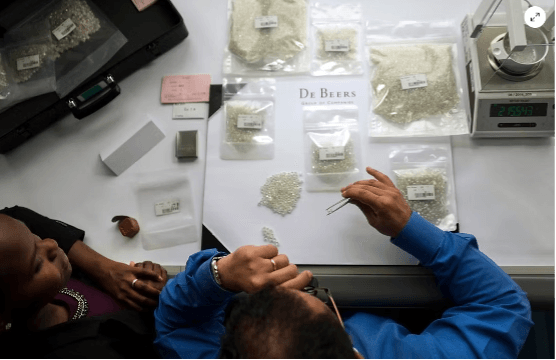
During an interview with De Beers CEO Al Cook in June, I asked him about the company’s inventory levels. To my surprise, he said De Beers had reduced inventory by about $100 million.
I asked how that was possible. By my calculation, based on production minus sales volume, the company had accumulated approximately 11.2 million carats of rough from the beginning of 2023 through the first quarter of 2025.
“We cut production across the board, which eased pressures across the midstream,” he said. The answer did not satisfy me. The numbers didn’t align, so I waited for further data before publishing.
That clarity came last week in Anglo American’s second-quarter production report. It showed that De Beers’ production dropped 36% year-on-year to 4.14 million carats, while sales volume declined just 3% to 7.56 million carats. The company reduced inventory by 3.42 million carats in the second quarter alone, and by 2.06 million carats over the first half of the year.
This is a notable achievement and may indicate some stabilization in the market compared to last year. However, Anglo American has warned that De Beers is expected to post a negative underlying EBITDA when it announces interim results on Thursday. Such a loss will no doubt reinforce the conglomerate’s resolve to sell its 85% stake in the diamond unit.
While the inventory reduction is a positive development for De Beers, it has come at a cost to Botswana. The country holds a 15% stake in De Beers and is an equal joint venture partner in both Debswana, the company’s local mining subsidiary, and DTC Botswana, which sells Debswana’s rough to De Beers’ global sales unit as well as to the state-run Okavango Diamond Company.
The government is now contending with a 31% drop in production, down to 8.24 million carats in the first half of the year — the lowest level since the COVID-related mine closures of 2020. Diamond production remains the largest contributor to Botswana’s gross domestic product, but it also affects government revenue from Debswana’s (or DTC Botswana’s) rough sales to De Beers. And with De Beers expected to post negative earnings, the government will not receive a dividend from its equity stake this half-year.
All of this adds context to President Duma Boko’s recent statement at a press conference that “De Beers is not doing its job.” His position was echoed last week by Mining Minister Bogolo Kenewendo, who reiterated the government’s intent to increase its stake in De Beers “to ensure Botswana’s full control over this strategic national asset.”
I remain unconvinced that increasing the national stake in De Beers is the right move, as I argued in my editorial, Botswana’s Diamond Obsession. A better path might be expanding Botswana’s share in Debswana and DTCB — even if that complicates other potential investments in De Beers.
As Anglo’s planned divestment drags on, Botswana’s position grows stronger — not only in asserting operational influence, but also in shaping the future ownership of De Beers. The government’s frustration is understandable, especially given claims by Boko and Kenewendo that Anglo has yet to engage it on a potential sale. If true, that lack of dialogue is concerning.
Botswana must demonstrate that it remains open and attractive to investors, as I’ve previously argued. At the same time, Anglo has a clear responsibility to ensure that any future deal meaningfully benefits Botswana. The country not only holds regulatory veto power over a sale, but it also has its economic future deeply tied to the outcome.
De Beers, meanwhile, is navigating a precarious balance. It cannot afford to keep building inventory while running at a loss, but nor can it continue to suppress production in Botswana without long-term consequences. Although Botswana is a minority shareholder, its strategic leverage is growing — and with it, its influence over De Beers’ future.
